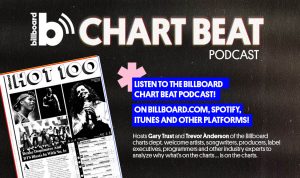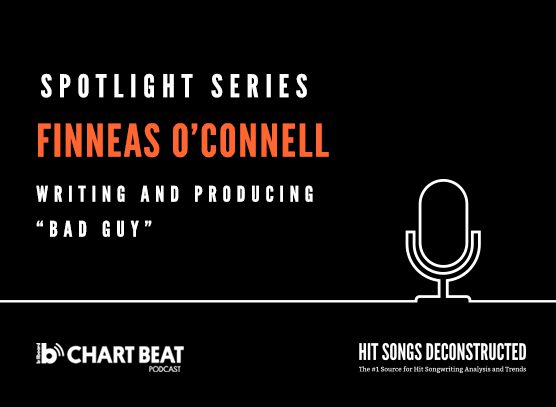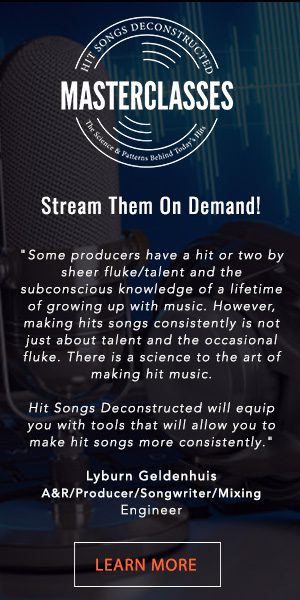We are thrilled to announce our new Spotlight Series, where sit down with some of today’s hottest and most influential music industry professionals, songwriters, producers, and artists to gain deep insight into their creative process, their inspirations, the stories behind their songs, and what drives them to succeed.
To kick things off, we partnered once again with our friends at the Billboard Chartbeat Podcast where we sat down with FINNEAS to get into the nitty-gritty behind how he, and his sister Billie, crafted the global smash, Bad Guy.
During the interview, we take a deep dive into the song from intro to outro, discussing the story behind how Bad Guy came to be, their writing process, the song’s production, the lyrics, and many of the highly unique elements that set Bad Guy apart from other Top 10 hits.
The interview concludes with advice FINNEAS has for aspiring songwriters and producers who want to score a major hit while still remaining true to their own artistic vision.

To listen to
Hit Song Deconstructed’s
interview with FINNEAS on
the Billboard Chart Beat Podcast, click here.
FINNEAS on the creation of Bad Guy
“I basically walked into Billie’s room, at some point in 2017, and I heard the basics of that beat, the high hat, and the 808 kick drum. And she’d been recording her own vocal for it, I believe. And it was the whole kind of last… forty seconds of the song…”
“…And then, we kind of didn’t really know what to do with it, so we just put it on hold.”
“And then I was with her, literally, seven or eight months later. And we were in my room just messing around on stuff, and I played the kick-drum/bass combo that is the whole root of the rest of the song… And it just already worked. It sounded really cool. “
“I think as soon as we were calling the song Bad Guy—I think we had written the hook of “I’m the bad guy.” We were like “Oh, well then they [the bass/kick groove and the outro] have to go after each other.”
“…I would bet that the total amount of days that we actually worked on the song is like four or five full days. But over the course of probably six months or seven months. And then the outro was obviously mostly written and recorded the summer before that. So, it was… a week and a half of work, over the course of a year.”
FINNEAS on Billie’s outro
“But one of the things I loved about what she’s done is that Billie was just starting out on producing. This is the first thing she’s produced, and so she hadn’t learned any of the stuff you’re supposed to NOT do in production. It was just distorting and clipping, and that was what I liked; it sounded really badass”
FINNEAS on writing Bad Guy’s melody
“And so, we started writing the verses, and the verses existed without us knowing that the song was gonna turn into Bad Guy. I played these chords over the top of the bass line and drum pattern, and playing the triad, it felt really cool, and then playing them at the rhythm that the vocal ended up being, and that was the inspiration to having the vocal always be three-part-harmony in the verse. And then, I’m assuming it was probably Billie’s idea to be like, ‘This song should be I’m the Bad Guy, and we should use that other part at the end of it.’”
FINNEAS on writing Bad Guy’s lyrics
“…we thought the rhythm sounded great, and then we basically just started pretending the lyrics into existence. I have this, white shirt, ‘White shirt, now red’ thing, and it was (a matter of) figuring out the rhymes, and figuring out the narrative, and it became really quickly a song about someone having a lot of bravado. And not really being the real deal. And just feeling like ‘Yeah, you think you’re all this. And really, I don’t have to brag about it, because I really am that.’ You know what I mean?”
FINNEAS on bringing the song together
“We weren’t certain until we tried everything, which I think is the best part about modern production and modern recording is you can make an unlimited amount of versions, y’know? And so we always kind of try every idea we have, and then we just let the best idea be the best idea. So, to me, I think the rest of the song is made really interesting by the outro, and I think the outro is made really interesting by the rest of the song. I feel like they really, really complement each other.”
FINNEAS on the writing process
“…most of the time, we write songs just on a piano or a guitar, and we just think of it and we record it later. But in this song’s case, we were recording it the whole time we were writing it, which I think was really informative, and really, we knew stuff worked and stuff didn’t work right away.”
“Usually it’s one day where we get a lot done, and then we work on other stuff for a while, and then we come back to it another day, and we get more done, and then we work on other stuff, and then we come back to it another day to make it almost finished. But I would bet that the total amount of days that we actually worked on the song is like four or five full days. But over the course of probably six months or seven months. And then the outro was obviously mostly written and recorded the summer before that. So, it was eight—a week and a half of work, over the course of a year.”
FINNEAS on producing Billie’s vocals
“We’ve evolved the way we approach the treatment of her vocals a lot, and one of the things we wanted to do on this record was never put in a reverb, or a delay that didn’t have a purpose to it. A lot of the time, in pop music especially, there’s a reverb, kind of, on the whole vocal of the whole song without much of an explanation. And the reason that is, is that reverb makes vocals sound better 99% of the time… and I have nothing against reverb. But one of our purposes, with this album, was to make it feel like you were sitting right next to Billie in our bedroom recording.”
“…everybody was really excited about the tremolo effect on the hook vocal, when she says, “I’m a bad guy.” It sounds like a rattle thing. I just feel like if I had had a bunch of reverb and delay on the rest of the song, that stuff wouldn’t be as noticeable.”
“And also, one of the things about Billie is her voice just rocks. So, I’m never trying to hide her voice from anybody. I just want everybody to—I’m like a proud dad.”
FINNEAS on using found sounds
“And then the other crazy thing about the production on the hook, or the chorus part A, is that there’s this little beeping happening at first on every two counts, and then on every count, and then every half count, and that’s the ‘wait’ tone of a stoplight in Australia. Billie and I were on tour in Australia and we heard their sound, and we thought it was awesome. And then the thing that sounds like it’s a high hat on sixteenth notes in the rest of the hook, isn’t a high hat, it’s actually the crosswalk, ‘go’ sound in Australia.”
“Well, I think to me it’s all about articulating the message of the song. Break My Heart Again has texting sounds because the premise of that song is that all the lines in the verses of that song are literally texts, me and my ex-girlfriend basically sent each other, which is crazy. So I wanted to help articulate that.”
“I just wanna have stuff that sounds unique and interesting. I use sample libraries and sounds that everybody has access to all the time ‘cause they’re great. But any time I have a sound that I find that I’m like, ‘Whoa, only I have this sound!’ Even if it’s a crosswalk in Australia where anybody could walk up to that, hear that, it’s like…only I’m using it. And I think that it’s those things are super exciting to me. And then in the case of Watch, where I strike matches, that’s even better because I’m literally standing in my bathroom with Billie striking matches until the smoke alarm goes off. It’s those things.”
FINNEAS on advice to aspiring songwriters and producers
“…study all the music that you love really hard. Study why you love it, what makes songs that you love great, structurally, and hook-wise, and lyric-wise, and tempo-wise. Study them all. Ingest that, write songs that give you similar feeling of songs that you love that are inspiring to you, make music that feels a little derivative to you, if you feel like it, just to learn how it feels to write a song like that. And then, once you’ve done all that, don’t be afraid to ignore all of your own advice, and make something that feels like it’s a completely different thing, and that it might never be a hit because there are no songs on the Billboard Top 10 this year that have instrumental hooks. And then maybe you’ll find yourself in the Top 10!”



